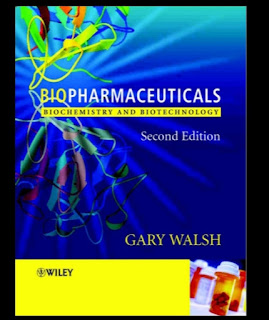PDF DOWNLOAD BIOPHARMACEUTICALS BIOCHEMISTRY AND BIOTECHNOLOGY FOR FREE|B PHARM BOOKS FREE DOWNLOAD
BIOPHARMACEUTICALS BIOCHEMISTRY AND BIOTECHNOLOGY Second Edition By Gary Walsh, Industrial Biochemistry Programme CES Department University of Limerick, Ireland
 |
| BIOPHARMACEUTICALS BIOCHEMISTRY AND BIOTECHNOLOGY Second Edition By Gary Walsh, Industrial Biochemistry Programme CES Department University of Limerick, Ireland |
Author:
Gary Walsh
Industrial Biochemistry Programme
CES Department
University of Limerick, Ireland
Download links:
PDF DOWNLOAD A TEXTBOOK OF BIOCHEMISTRY B PHARM 2ND SEMESTER FREE
About
Advances in our understanding of the molecular principles underlining both health and disease has revealed the existence of many regulatory polypeptides of significant medical potential. The fact that such polypeptides are produced naturally within the body only in minute quantities initially precluded their large-scale medical application. The development in the 1970s of the twin techniques of genetic engineering and hybridoma technology marked the birth of the modern biotech era. These techniques facilitate the large-scale production of virtually any protein, and proteins of medical interest produced by these methodologies have been coined 'biopharmaceuticals’. More recent developments in biomedical research highlights the clinical potential of nucleic acid-based therapeutic agents. Gene therapy and anti-sense technology are likely to become a medical reality within a decade. The term ‘biopharmaceutical’ now also incorporates the polynucleotide sequences utilized for such purposes. This book attempts to provide a balanced overview of the biopharmaceutical industry, not only in terms of categorizing the products currently available but also illustrating how these drugs are produced and brought to market. Chapter 1 serves as an introduction to the topic, and also focuses upon several ‘traditional’ pharmaceutical substances isolated (initially at least) from biological sources. This serves as a backdrop for the remaining chapters, which focus almost exclusively upon recently developed biopharmaceutical products. The major emphasis is placed upon polypeptide-based therapeutic agents, while the potential of nucleic acid-based drugs is discussed in the final chapter.
In preparing the latest edition of this textbook, I highlight the latest developments within the sector, provide a greater focus upon actual commercial products thus far approved and how they are manufactured, and I include substantial new sections detailing biopharmaceutical drug delivery and how advances in genomics and proteomics will likely impact upon (bio)pharmaceutical drug development.
The major target audience is that of advanced undergraduates or postgraduate students pursuing courses in relevant aspects of the biological sciences. The book should prove particularly interesting to students undertaking programs in biotechnology, biochemistry, the pharmaceutical sciences, medicine, or any related biomedical subject. A significant additional target audience is those already employed in the (bio)pharmaceutical sector, who wish to gain a better overview of the industry in which they work.
The successful completion of this text has been made possible by the assistance of several people to whom I owe a depth of gratitude. Chief amongst these is Sandy Lawson, who appears to be able to read my mind as well as my handwriting. Thank you to Nancy, my beautiful wife, who suffered most from my becoming a social recluse during the preparation of this text. Thank you, Nancy, for not carrying out your threat to burn the manuscript on various occasions, and for helping with the proofreading. I am also very grateful to the staff of John Wiley and Sons Ltd for the professionalism and efficiency they exhibited while bringing this book through the






![[DOWNLOAD PDF] COSMETIC SCIENCE CONCEPTS AND PRINCIPLES by Nirali publication free| B. PHARM. Semester VIII book download 2021](https://blogger.googleusercontent.com/img/b/R29vZ2xl/AVvXsEhOaVWgECE7p1O2cvLYu_-Co-3BOPx9KblZRJlheflYcS8tVaZLFO-t_jEqxVQHNAsHZZOt9i3uEltq6qEhdKy7-xaN094EInFj5D6O6HCUimpPkCGBhMMtotMVW6nn4eZXbhKSdMICCUrw/w72-h72-p-k-no-nu/PicsArt_06-16-07.01.29.jpg)

0 Comments